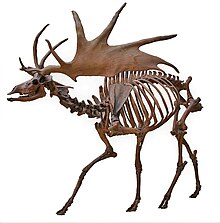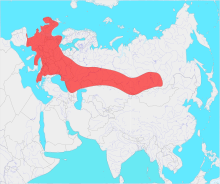
Back Megaloceros giganteus AN أيل أيرلندي Arabic Böyük buynuzlu maral Azerbaijani Megaloceros giganteus Catalan Megaloceros giganteus CEB Megaloceros giganteus Czech Irsk kæmpehjort Danish Giganta cervo Esperanto Megaloceros giganteus Spanish Ürghirv Estonian
| Irish elk Temporal range: Middle Pleistocene to Middle Holocene,
| |
|---|---|

| |
| Mounted skeleton | |
| Scientific classification | |
| Domain: | Eukaryota |
| Kingdom: | Animalia |
| Phylum: | Chordata |
| Class: | Mammalia |
| Order: | Artiodactyla |
| Family: | Cervidae |
| Subfamily: | Cervinae |
| Genus: | †Megaloceros |
| Species: | †M. giganteus
|
| Binomial name | |
| †Megaloceros giganteus (Blumenbach, 1799)
| |

| |
| Time averaged range of M. giganteus during the Late Pleistocene | |
| Synonyms | |
| |
The Irish elk (Megaloceros giganteus),[1][2] also called the giant deer or Irish deer, is an extinct species of deer in the genus Megaloceros and is one of the largest deer that ever lived. Its range extended across Eurasia during the Pleistocene, from Ireland (where it is known from abundant remains found in bogs) to Lake Baikal in Siberia. The most recent remains of the species have been radiocarbon dated to about 7,700 years ago in western Russia.[3][4] Its antlers, which can span 3.5 metres (11 ft) across are the largest known of any deer.[5] It is not closely related to either living species called the elk, with it being widely agreed that its closest living relatives are fallow deer (Dama).[5][6][7][8]
- ^ Geist, Valerius (1998). "Megaloceros: The Ice Age Giant and Its Living Relatives". Deer of the World: Their Evolution, Behaviour, and Ecology. Stackpole Books. ISBN 978-0-8117-0496-0.
- ^ Lister, A.M. (1987). "Megaceros or Megaloceros? The nomenclature of the giant deer". Quaternary Newsletter. 52: 14–16.
- ^ Stuart, A.J.; Kosintsev, P.A.; Higham, T.F.G.; Lister, A.M. (2004). "Pleistocene to Holocene extinction dynamics in giant deer and woolly mammoth" (PDF). Nature. 431 (7009): 684–689. Bibcode:2004Natur.431..684S. doi:10.1038/nature02890. PMID 15470427. S2CID 4415073. Archived from the original (PDF) on 14 September 2006. Supplementary information. Erratum in Stuart, A. J. (2005). "Erratum: Pleistocene to Holocene extinction dynamics in giant deer and woolly mammoth". Nature. 434 (7031): 413. Bibcode:2005Natur.434..413S. doi:10.1038/nature03413.
- ^ Lister, Adrian M.; Stuart, Anthony J. (January 2019). "The extinction of the giant deer Megaloceros giganteus (Blumenbach): New radiocarbon evidence". Quaternary International. 500: 185–203. Bibcode:2019QuInt.500..185L. doi:10.1016/j.quaint.2019.03.025.
- ^ a b Lister, Adrian M.; Edwards, Ceiridwen J.; Nock, D. A. W.; Bunce, Michael; van Pijlen, Iris A.; Bradley, Daniel G.; Thomas, Mark G.; Barnes, Ian (2005). "The phylogenetic position of the giant deer Megaloceros giganteus". Nature. 438 (7069): 850–853. Bibcode:2005Natur.438..850L. doi:10.1038/nature04134. PMID 16148942. S2CID 4396326.
- ^ Hughes, Sandrine; Hayden, Thomas J.; Douady, Christophe J.; Tougard, Christelle; Germonpré, Mietje; Stuart, Anthony; Lbova, Lyudmila; Carden, Ruth F.; Hänni, Catherine; Say, Ludovic (2006). "Molecular phylogeny of the extinct giant deer, Megaloceros giganteus". Molecular Phylogenetics and Evolution. 40 (1): 285–291. Bibcode:2006MolPE..40..285H. doi:10.1016/j.ympev.2006.02.004. PMID 16556506.
- ^ Immel, Alexander; Drucker, Dorothée G.; Bonazzi, Marion; Jahnke, Tina K.; Münzel, Susanne C.; Schuenemann, Verena J.; Herbig, Alexander; Kind, Claus-Joachim; Krause, Johannes (2015). "Mitochondrial Genomes of Giant Deers Suggest their Late Survival in Central Europe". Scientific Reports. 5 (10853): 10853. Bibcode:2015NatSR...510853I. doi:10.1038/srep10853. PMC 4459102. PMID 26052672.
- ^ Mennecart, Bastien; DeMiguel, Daniel; Bibi, Faysal; Rössner, Gertrud E.; Métais, Grégoire; Neenan, James M.; Wang, Shiqi; Schulz, Georg; Müller, Bert; Costeur, Loïc (13 October 2017). "Bony labyrinth morphology clarifies the origin and evolution of deer". Scientific Reports. 7 (1): 13176. Bibcode:2017NatSR...713176M. doi:10.1038/s41598-017-12848-9. ISSN 2045-2322. PMC 5640792. PMID 29030580.
© MMXXIII Rich X Search. We shall prevail. All rights reserved. Rich X Search